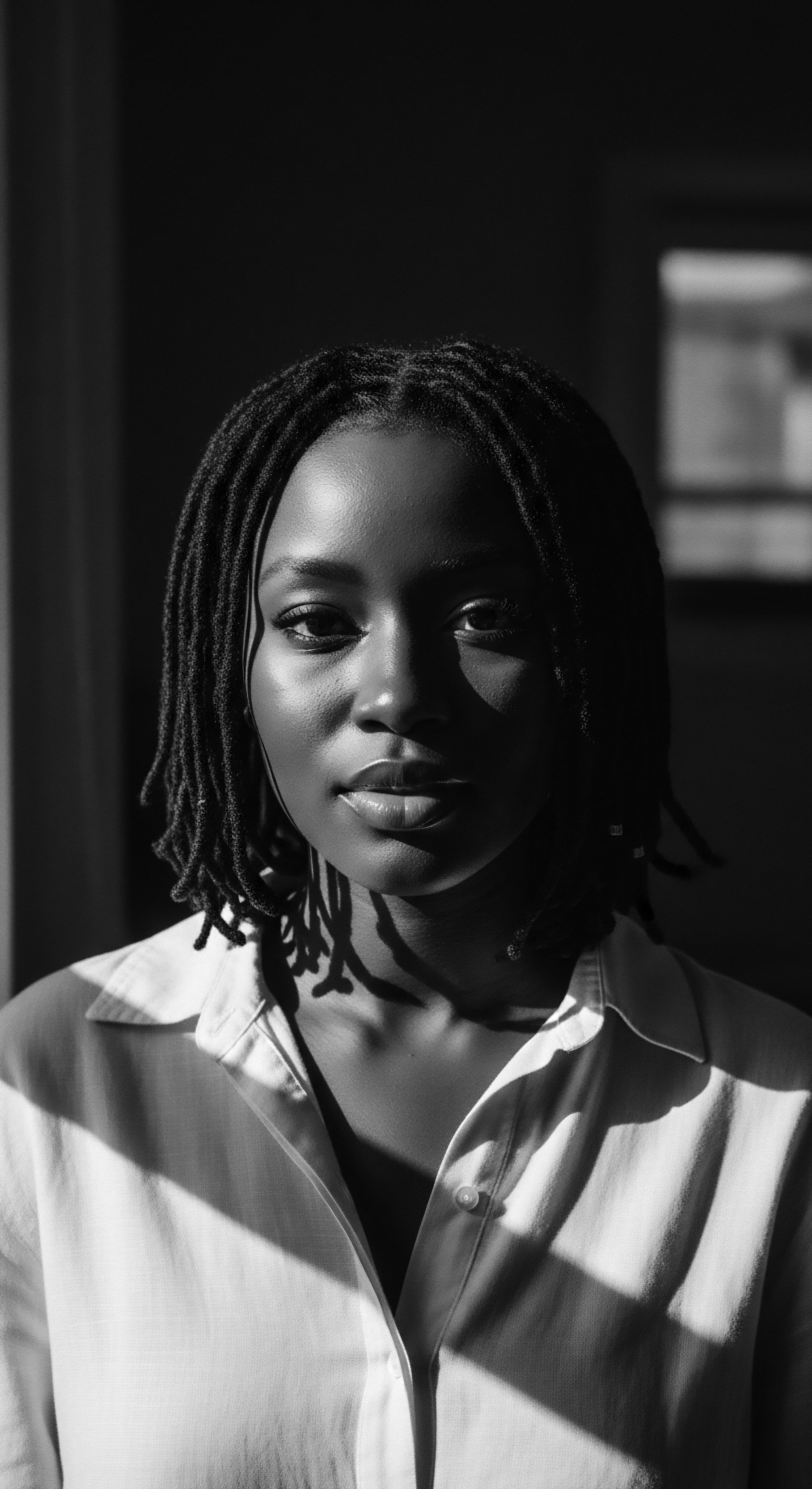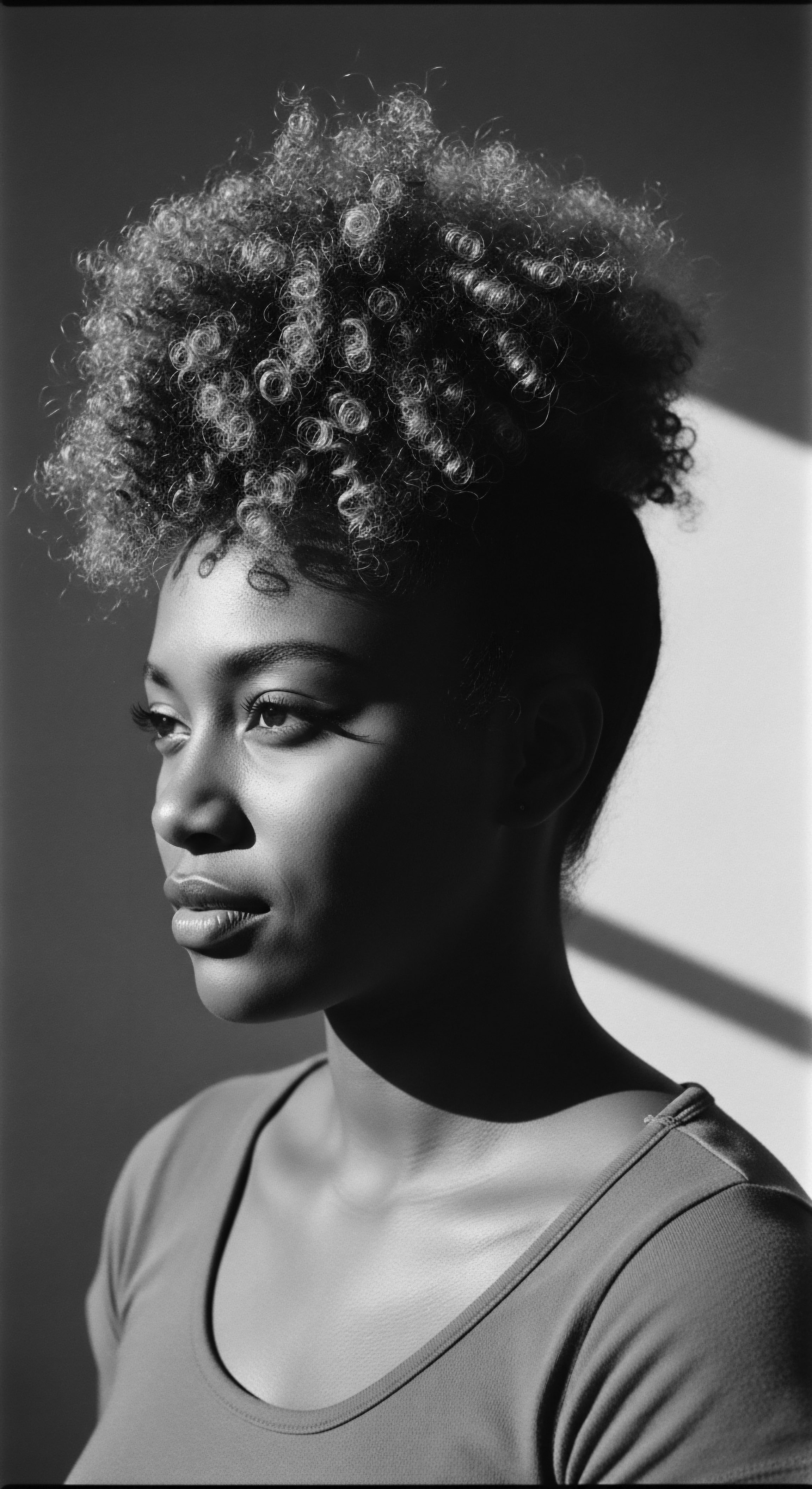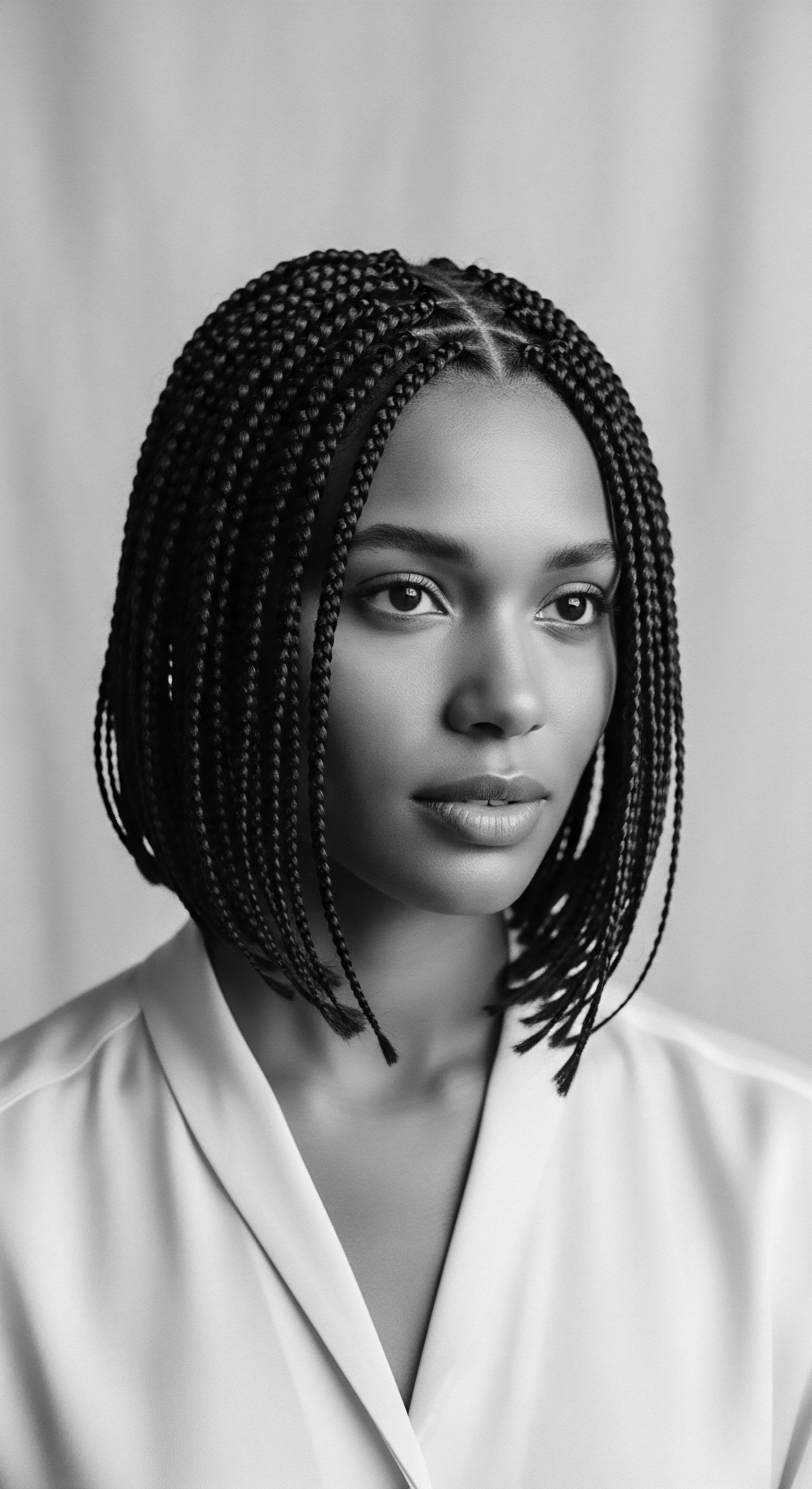
Fundamentals
The concept of Gentle Cleansing, within Roothea’s living library, represents far more than a mere removal of impurities from hair. It embodies a philosophy of care, a reverence for the intrinsic nature of textured strands, and a profound acknowledgment of the ancestral wisdom that has long guided the preservation of hair health. For those beginning to explore the nuances of textured hair care, Gentle Cleansing offers a foundational understanding ❉ it is the art of purifying the scalp and hair while safeguarding its inherent moisture, respecting its delicate structure, and honoring its natural state.
This approach stands in thoughtful contrast to harsh, stripping methods that can compromise the vitality of curls, coils, and waves. Instead, it prioritizes a balanced equilibrium, ensuring that the cleansing process leaves the hair feeling refreshed and light, yet deeply nourished and pliable. The initial understanding of Gentle Cleansing requires a shift in perspective, moving away from the aggressive lather often associated with cleanliness towards a more considerate interaction with each strand.

What is Gentle Cleansing?
At its simplest, Gentle Cleansing refers to a method of purifying hair and scalp that avoids harsh chemicals and aggressive mechanical action. Its primary objective is to remove excess oils, dirt, and product residue without stripping the hair of its natural protective lipids. This careful removal maintains the hair’s moisture balance, which is particularly vital for textured hair types, known for their predisposition to dryness. The term ‘cleansing’ here extends beyond superficial washing; it denotes a thoughtful process designed to support the hair’s long-term health and structural integrity.
Gentle Cleansing is a respectful purification of textured hair, honoring its natural moisture and structural integrity.
The significance of this practice for textured hair lies in its unique anatomical and physiological characteristics. Unlike straight hair, the elliptical shape of textured hair follicles results in strands that coil and curve, making it more challenging for natural oils (sebum) to travel down the hair shaft. This inherent structural quality means textured hair is often drier and more susceptible to breakage, making the preservation of moisture paramount during any cleansing ritual. A gentle approach ensures that the hair’s natural defenses are not diminished, allowing it to retain its elasticity and vibrancy.

Why It Matters for Textured Hair
For curls, coils, and waves, the application of gentle cleansing principles is not merely a preference; it is a fundamental requirement for well-being. The cuticle, the outermost layer of the hair, consists of overlapping scales. In textured hair, these scales tend to be naturally more lifted or open, which, while allowing moisture to enter, also allows it to escape more readily.
Harsh detergents can exacerbate this, leading to increased porosity and a feeling of dryness and brittleness. A gentle cleansing regimen, therefore, becomes a shield against such vulnerabilities.
Furthermore, the very nature of textured hair means it is more prone to tangling and knotting. Aggressive washing can worsen this, leading to mechanical damage during detangling. Gentle Cleansing, by contrast, minimizes friction and allows for a smoother, more deliberate detangling process, reducing strain on the delicate hair strands. It supports the hair’s natural pattern, allowing it to unfurl and express its true texture without unnecessary disruption.

Early Echoes of Care
The wisdom of gentle care for textured hair is not a contemporary invention; its echoes resonate through ancestral practices across the African diaspora and beyond. Long before modern formulations, communities understood the delicate balance required to maintain hair health. They utilized natural elements found in their environments, instinctively gravitating towards ingredients that cleansed without stripping. This early understanding forms the bedrock of what we now articulate as Gentle Cleansing, a testament to enduring knowledge passed through generations.
For example, historical records and ethnobotanical studies reveal the use of plant-based cleansers. In various African communities, plant extracts with mild saponin properties were employed to purify hair and scalp. These traditions laid the groundwork for a philosophy of care that valued sustenance and preservation over harsh chemical intervention.

Intermediate
Moving beyond the foundational understanding, an intermediate exploration of Gentle Cleansing reveals its deeper operational principles and the diverse forms it can assume. This level of insight considers the specific mechanisms by which cleansing agents interact with hair and scalp, emphasizing the critical balance required to maintain an optimal environment for textured hair growth and vitality. The concept transcends simple product selection, delving into the nuances of ingredient chemistry and their historical counterparts.
Understanding Gentle Cleansing at this stage involves recognizing the subtle distinctions between various cleansing agents and how they contribute to or detract from hair health. It prompts an inquiry into the ancestral techniques that intuitively aligned with these principles, offering a rich historical context for contemporary practices. This layer of comprehension connects the elemental biology of the hair strand to the living traditions of care that have shaped its heritage.

Beyond Suds ❉ The Science of Gentle
The effectiveness of Gentle Cleansing is rooted in its respect for the hair’s natural pH balance and the integrity of its cuticle layer. Hair and scalp typically maintain a slightly acidic pH, which helps keep the cuticle flat and sealed, protecting the inner cortex and preventing moisture loss. Many traditional shampoos, especially those containing harsh sulfates, can be overly alkaline, causing the cuticle to lift and leaving hair vulnerable to dryness and damage. Gentle cleansers, by design, operate within a more acidic or neutral range, preserving this delicate balance.
Moreover, the choice of surfactants—the cleansing agents responsible for removing dirt and oil—is paramount. Gentle cleansers often employ milder, plant-derived surfactants that effectively lift impurities without excessively stripping the hair’s natural oils. This scientific understanding validates the long-standing wisdom of using natural substances that inherently possess a less aggressive interaction with the hair fiber.
Gentle Cleansing champions the hair’s natural pH, a scientific validation of ancestral practices that protected delicate strands.

The Spectrum of Cleansing Agents
The realm of Gentle Cleansing encompasses a spectrum of approaches, each tailored to different needs and historical contexts.
- Low-Poo Cleansers ❉ These formulations contain reduced concentrations of sulfates or utilize milder, non-sulfate surfactants. They offer a light lather and cleanse without excessive stripping, representing a modern interpretation of gentle purification.
- Co-Washing (Conditioner-Only Washing) ❉ This method involves using a conditioner, rather than a traditional shampoo, to cleanse the hair. Conditioners contain small amounts of cleansing agents that lift surface dirt and oils while providing significant moisture and slip, making it a popular choice for very dry or coily hair types. This technique aligns with the ancestral understanding of moisture preservation as a central tenet of hair care.
- Clay Washes ❉ Drawing from ancient practices, clay washes utilize natural clays like rhassoul or bentonite. These clays possess a negative charge, which helps to draw out positively charged impurities and toxins from the hair and scalp without stripping natural oils. They offer a detoxifying cleanse while also providing minerals and conditioning properties.
- Herbal Infusions and Plant-Based Washes ❉ Many ancestral traditions relied on the saponin-rich properties of plants. For instance, in parts of India, ingredients such as Shikakai (Acacia concinna) and Reetha (Sapindus mukorossi, or soapberries) were boiled to create a mild, natural lather for hair cleansing. These methods exemplify a profound connection to the earth’s offerings for hair sustenance.

Scalp as Sacred Ground
A truly gentle cleansing ritual extends its focus beyond the hair strands to the scalp, recognizing it as the living foundation from which hair emerges. Ancestral wisdom consistently treated the scalp with reverence, understanding its connection to overall well-being. Modern science affirms this by highlighting the importance of a balanced scalp microbiome for healthy hair growth. Gentle cleansing methods help to maintain this delicate ecosystem, preventing irritation, dryness, or excessive oiliness that can disrupt the scalp’s natural functions.
The practice of massaging the scalp during cleansing, a ritual often observed in traditional African and Ayurvedic practices, stimulates blood circulation and promotes nutrient delivery to the hair follicles. This deliberate, mindful interaction with the scalp, often accompanied by the application of nourishing oils or plant-based infusions, transforms a routine task into a restorative act, connecting the individual to a lineage of holistic self-care.
| Aspect of Care Cleansing Agent Source |
| Ancestral Practices (Echoes from the Source) Plant-based saponins (e.g. soapberries, shikakai, African black soap variations), natural clays, fermented grains. |
| Contemporary Gentle Cleansing (The Tender Thread) Sulfate-free surfactants, cocamidopropyl betaine, decyl glucoside, plant-derived emulsifiers. |
| Aspect of Care Primary Objective |
| Ancestral Practices (Echoes from the Source) Purification, moisture retention, scalp nourishment, spiritual preparation, community bonding. |
| Contemporary Gentle Cleansing (The Tender Thread) Removing buildup without stripping, preserving natural oils, maintaining pH balance, enhancing curl definition. |
| Aspect of Care Application Method |
| Ancestral Practices (Echoes from the Source) Slow, deliberate application, often with scalp massage; communal grooming rituals. |
| Contemporary Gentle Cleansing (The Tender Thread) Finger-pad massage on scalp, gentle emulsification, minimal manipulation of strands. |
| Aspect of Care Post-Cleansing Rituals |
| Ancestral Practices (Echoes from the Source) Oiling with plant butters (e.g. shea butter) and oils, herbal rinses, protective styling. |
| Contemporary Gentle Cleansing (The Tender Thread) Deep conditioning, leave-in conditioners, sealing with oils, protective styling. |
| Aspect of Care This table highlights the continuous wisdom in hair care, demonstrating how modern gentle cleansing principles mirror the holistic, protective intentions of ancestral practices. |

Academic
The academic elucidation of Gentle Cleansing transcends a simple definition, revealing a complex interplay of biophysical principles, historical imperatives, and profound psychosocial implications, particularly within the context of textured hair heritage. This is not merely a method; it is a declaration of self-possession, a re-establishment of ancestral connection, and a scientifically grounded approach to maintaining the unique vitality of Black and mixed-race hair. Its meaning is a layered construct, shaped by centuries of cultural evolution, resistance, and the enduring quest for authentic well-being.
The interpretation of Gentle Cleansing demands an understanding of its deep historical roots, its scientific underpinnings, and its role as a counter-narrative to imposed beauty standards. It represents a conscious decision to honor the inherent structure and needs of textured hair, moving beyond superficial aesthetics to address the very substance and essence of hair health from a holistic, culturally informed perspective.

The Ancestral Mandate of Moisture
The inherent morphology of afro-textured hair, characterized by its elliptical cross-section and numerous twists and turns, renders it particularly susceptible to moisture loss. This structural reality means that sebum, the scalp’s natural conditioning oil, struggles to traverse the entire length of the hair shaft, leaving the ends often drier and more vulnerable. Consequently, ancestral hair care practices across African civilizations and the diaspora intuitively centered on moisture preservation and replenishment. Cleansing rituals were never about aggressive stripping; they were about maintaining a delicate balance, a respectful removal of impurities that did not compromise the hair’s vital hydration.
Ethnobotanical studies affirm this deep-seated understanding. For instance, the traditional use of Chebe Powder by women in Chad, a mixture of ground seeds and other natural ingredients, is not primarily a cleanser but a treatment applied to the hair to seal in moisture, leading to impressive length retention. While not a direct cleansing agent, its consistent application within a broader care regimen underscores a historical emphasis on moisture and preservation that gentle cleansing inherently respects. This practice, passed through generations, illustrates a sophisticated understanding of hair’s needs long before the advent of modern cosmetic science.

The Biophysical Blueprint of Textured Strands
From a biophysical standpoint, the significance of Gentle Cleansing for textured hair is undeniable. The outermost layer of the hair, the cuticle, comprises overlapping cells that resemble shingles on a roof. In straight hair, these scales lie relatively flat.
However, in textured hair, particularly those with tighter curl patterns, the cuticle scales are naturally more lifted or open at the bends of the coils. This structural configuration means that textured hair is predisposed to higher porosity, allowing moisture to enter and escape more readily.
Aggressive cleansing agents, often laden with harsh sulfates, possess strong anionic properties that can excessively lift these cuticle scales, leading to increased friction, tangling, and ultimately, mechanical damage and breakage. Such practices disrupt the hair’s natural barrier, leaving the cortex, the inner protein structure, exposed and vulnerable to environmental stressors. Gentle Cleansing, conversely, employs milder surfactants that minimize cuticle disruption, thereby preserving the hair’s natural protective layer and optimizing its capacity to retain essential hydration. This scientific elucidation provides a compelling rationale for the adoption of gentle practices, validating the intuitive wisdom of generations who sought to protect these unique strands.
Textured hair’s unique cuticle structure necessitates gentle cleansing to prevent moisture loss and preserve its inherent resilience.

Reclaiming the Crown ❉ Historical Acts of Gentle Care
The historical trajectory of Black and mixed-race hair care is inextricably linked to broader socio-political narratives, where hair has served as a profound symbol of identity, resistance, and cultural continuity. During the transatlantic slave trade, the forced shaving of heads upon arrival in the Americas was a deliberate act of dehumanization, stripping enslaved individuals of a vital connection to their heritage and identity. Despite such oppressive measures, ancestral hair practices endured, often in secret, utilizing available natural resources for care. This clandestine continuity laid the groundwork for a legacy of self-reliant hair care, where gentle methods were born of necessity and cultural preservation.
The mid-20th century saw a significant shift in hair practices within the Black community, driven by societal pressures to conform to Eurocentric beauty standards. Chemical relaxers, designed to permanently straighten afro-textured hair, became widespread. These lye-based formulations, while offering a semblance of conformity, often caused significant damage to the hair and scalp, leading to breakage, thinning, and chemical burns. The desire for acceptance often overshadowed the inherent health implications.
A powerful counter-movement emerged during the Civil Rights era and gained renewed momentum in the 2000s ❉ the natural hair movement. This movement was not merely a stylistic choice; it was a profound political and cultural statement, a reclamation of Black identity and a rejection of imposed beauty ideals. As Ayana Byrd and Lori Tharps articulate in their seminal work, Hair Story ❉ Untangling the Roots of Black Hair in America (2001), this shift represented a new way of defining beauty, one that celebrated the inherent qualities of Black hair and challenged centuries of societal pressure to alter its natural state.
The embrace of natural textures inherently necessitated a return to gentle cleansing and care practices, moving away from the damaging cycle of chemical straightening towards methods that honored the hair’s integrity. This historical turning point underscores the profound significance of Gentle Cleansing as an act of self-love, cultural affirmation, and liberation.
The natural hair movement, therefore, acted as a catalyst for a widespread re-evaluation of cleansing practices. It brought forth a collective consciousness about the detrimental effects of harsh chemicals and the wisdom of nourishing hair with gentler, often plant-derived, alternatives. This return to gentler methods was not simply a trend; it was a deeply rooted reconnection to ancestral ways of care, a testament to the resilience of cultural heritage.

The Communal Cadence of Cleansing Rituals
Beyond individual practice, Gentle Cleansing, throughout history, has possessed a communal dimension within many Black and mixed-race communities. Hair care, including cleansing, was often a shared activity, particularly among women. These moments in “kitchen beauty shops” or communal spaces served as sites for storytelling, intergenerational knowledge transfer, and the strengthening of familial bonds. The rhythmic movements of detangling, the application of nourishing concoctions, and the gentle washing of strands created a sacred space for connection and the transmission of cultural wisdom.
This communal cadence fostered a collective understanding of what constitutes proper care for textured hair. It was in these shared spaces that the value of gentle manipulation, the importance of moisture, and the efficacy of natural ingredients were implicitly and explicitly taught. The ritualistic nature of cleansing, far from being a solitary chore, became a powerful reaffirmation of identity and belonging, further cementing the meaning of gentle care within the broader cultural fabric.

Gentle Cleansing as a Continuum of Identity
The contemporary meaning of Gentle Cleansing, therefore, is not static; it is a dynamic concept that continually evolves while remaining tethered to its historical and cultural moorings. It represents a conscious choice to prioritize the health and authenticity of textured hair, recognizing its unique needs and celebrating its inherent beauty. This practice contributes to a positive self-perception, empowering individuals to embrace their natural hair as a symbol of heritage and strength.
Moreover, the widespread adoption of gentle cleansing practices reflects a broader societal shift towards acknowledging and valuing diverse beauty standards. It challenges the lingering vestiges of Eurocentric ideals that once marginalized textured hair, paving the way for a more inclusive and respectful understanding of beauty. The continuous pursuit of gentle cleansing techniques, informed by both ancestral wisdom and modern scientific understanding, signifies an ongoing commitment to the well-being of textured hair and the communities that cherish it. This continuous exploration of its meaning and significance ensures that Gentle Cleansing remains a living, breathing entry in Roothea’s library, a testament to resilience and the enduring power of heritage.
The concept of Gentle Cleansing, therefore, stands as a testament to the profound relationship between identity, cultural practice, and physiological well-being. It is a nuanced understanding that acknowledges the specific challenges and unique strengths of textured hair, offering a pathway to care that is both deeply respectful and scientifically informed. This comprehensive explanation of its meaning underscores its central position within the holistic framework of textured hair care.
- Historical Cleansing Agents ❉ Early forms of hair cleansing often involved natural elements. In ancient India, boiling Soapberries (reetha) with other herbs like amla and hibiscus created a mild, saponin-rich lather for purification.
- Cultural Hair Practices ❉ Across various African communities, hair care was a significant cultural practice, with styles and cleansing rituals conveying social status, age, and spiritual beliefs.
- The Natural Hair Movement ❉ The resurgence of natural hair in the 1960s and 2000s directly influenced the embrace of gentle cleansing, as individuals moved away from damaging chemical straighteners to preserve their hair’s natural texture and health.
- Hair Porosity and Moisture ❉ Textured hair often exhibits higher porosity due to lifted cuticle scales, making gentle cleansing crucial for retaining moisture and preventing dryness.

Reflection on the Heritage of Gentle Cleansing
As we draw this meditation on Gentle Cleansing to a close, the resonant truth emerges ❉ it is not merely a transient trend or a fleeting product claim, but an enduring philosophy, deeply etched into the very Soul of a Strand. Its meaning, continually re-examined through the lens of Textured Hair Heritage, speaks to a lineage of resilience, innovation, and profound self-acceptance. From the elemental biology of the coil to the communal rhythms of ancestral care, Gentle Cleansing has always been a quiet act of defiance against narratives that sought to diminish the inherent beauty of Black and mixed-race hair.
The wisdom passed down through generations, often through whispered remedies and practiced hands, instinctively understood the delicate equilibrium required to nurture hair that defies gravity and dances with unique patterns. This ancient knowing, now affirmed by scientific inquiry, forms the bedrock of our contemporary understanding. It is a reminder that the most profound insights often lie not in complex formulations alone, but in a respectful return to fundamental principles—those tender threads connecting us to our past, our communities, and our authentic selves.
In Roothea’s living library, Gentle Cleansing stands as a testament to the enduring power of cultural memory. It invites each individual to partake in a ritual that extends beyond personal grooming, becoming a conscious act of honoring an ancestral legacy. The gentle touch, the thoughtful choice of ingredients, the patient unraveling of knots—these are not just steps in a routine; they are echoes of a heritage that celebrates every twist, every curl, every resilient strand as a precious part of a living story. This continuous journey of understanding and application ensures that the wisdom of gentle care will continue to voice identity and shape futures, one beautifully cleansed helix at a time.

References
- Byrd, A. & Tharps, L. (2001). Hair Story ❉ Untangling the Roots of Black Hair in America. St. Martin’s Press.
- Byrd, A. & Tharps, L. (2014). Hair Story ❉ Untangling the Roots of Black Hair in America (Revised and Updated Edition). St. Martin’s Press.
- Massey, L. (2001). Curly Girl ❉ The Handbook. Workman Publishing Company.
- Davis, A. (1971). If They Come in the Morning ❉ Voices of Resistance. The Third Press.
- Roberts, E. (2000). The Black Hair Handbook ❉ A Guide to Hair Care and Styling for African Americans. Citadel Press.
- Opoku, A. (2008). African Traditional Religion ❉ An Introduction. Waveland Press.
- Kimbell, R. (Director). (2005). My Nappy Roots ❉ A Journey Through Black Hair-itage . RKG Productions.
- Banks, I. (2000). Hair Matters ❉ Beauty, Power, and Black Women’s Consciousness. New York University Press.
- Patel, M. (2014). Hair Restoration Surgery in African Americans. Thieme.
- Tress, M. (2018). The Science of Black Hair ❉ A Comprehensive Guide to Textured Hair Care. CreateSpace Independent Publishing Platform.
